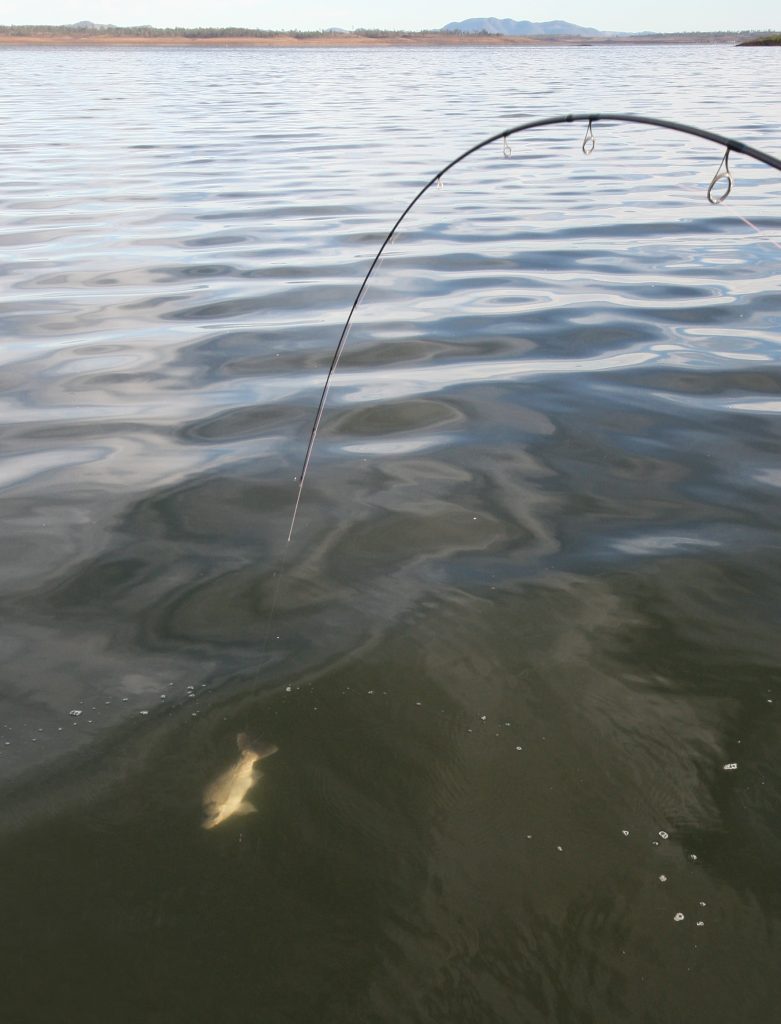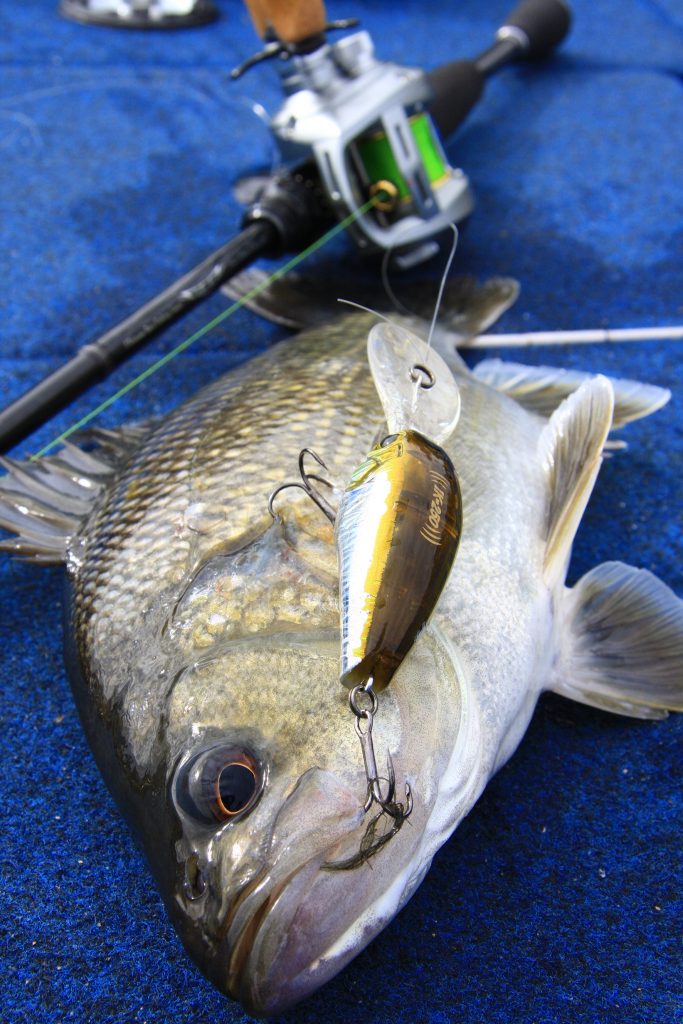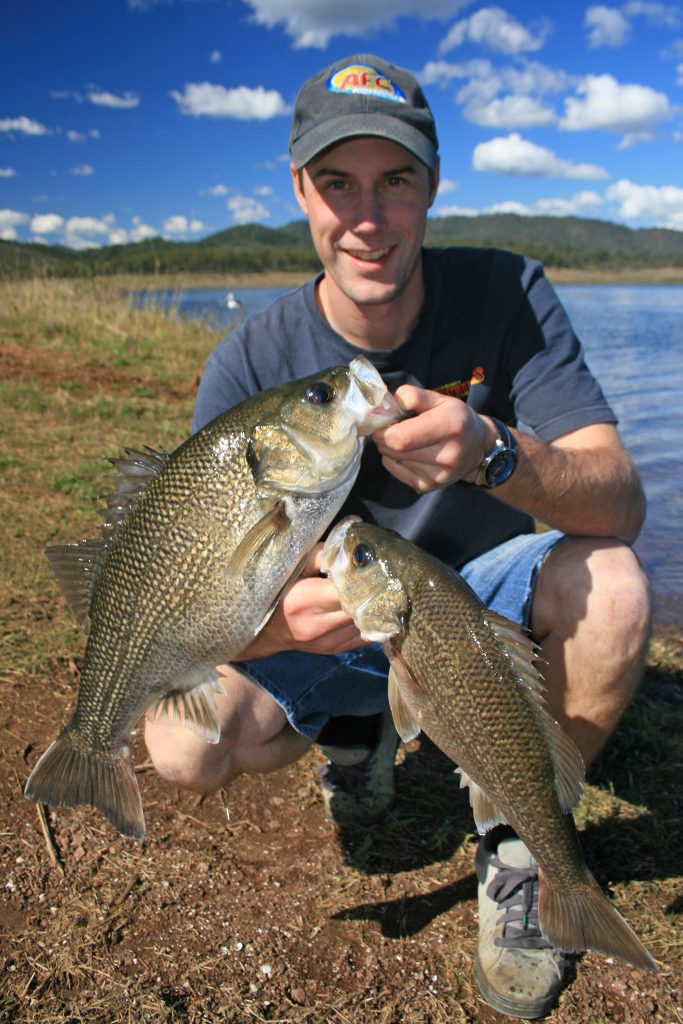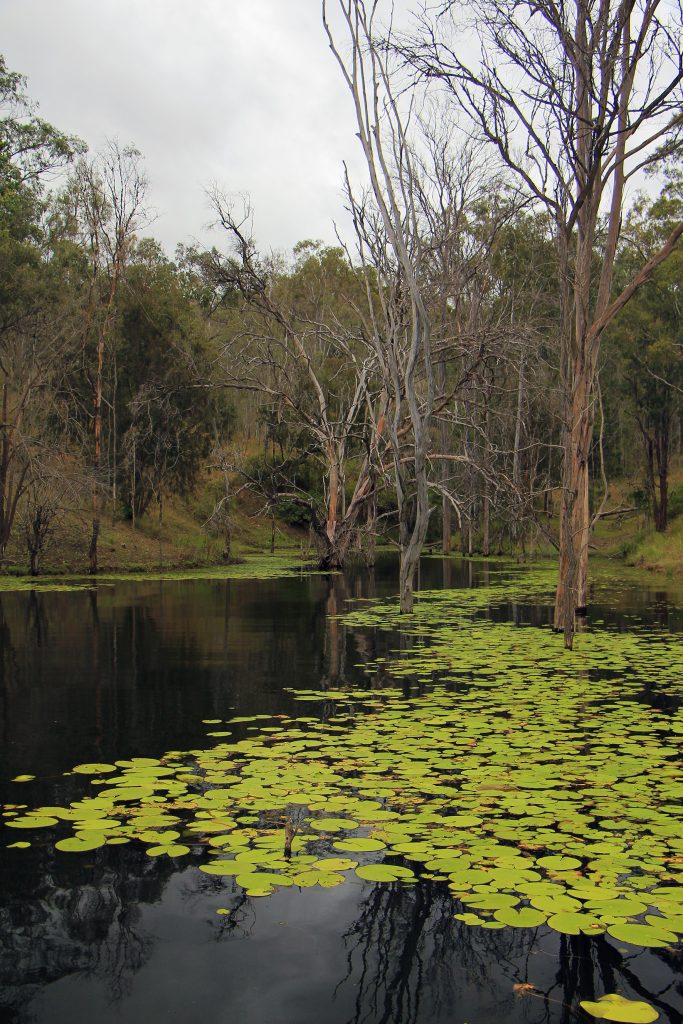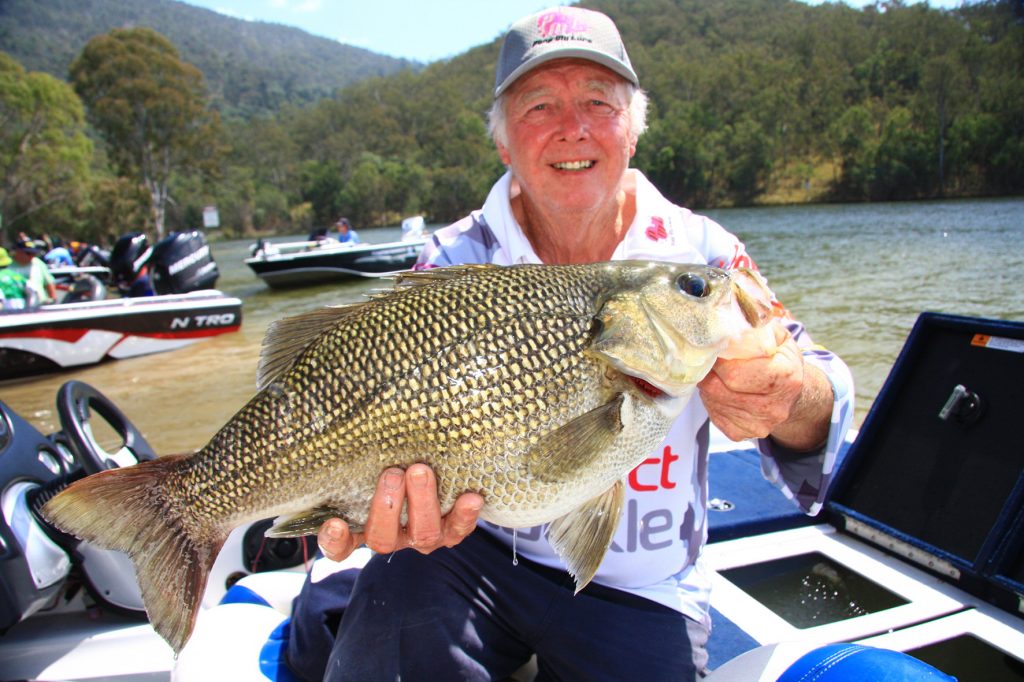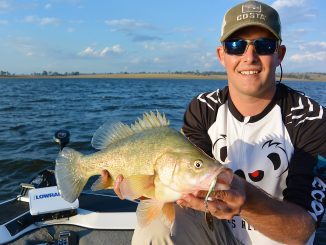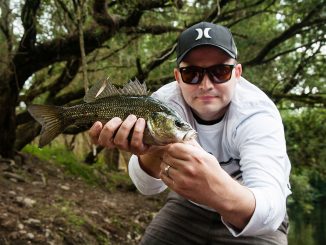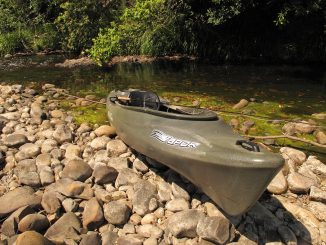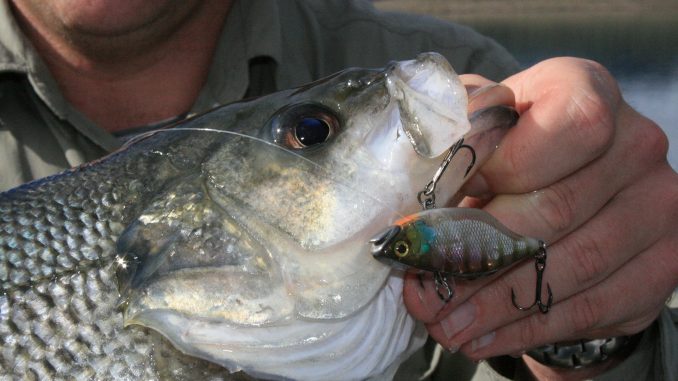
By Simon Goldsmith •
When it comes to freshwater sportfish it’s hard to go past the Australian bass. An iconic species that was instrumental in the evolution of sportfishing and catch and release tournament angling in Australia, few species can match the Aussie bass for angling diversity and fighting ability.
Whether you’re a seasoned tournament angler or a budding beginner, Australia bass have a lot to offer. From tramping remote eastern flowing streams in search of near virginal bass water to battling crowded schools on flats at Lake Somerset and Glenbawn, the Aussie bass is a species that appeals to many, and can be caught by plenty.
If you’re new to the world of bass fishing, knowing where and how to get started can be somewhat daunting. It doesn’t have to be though, and if you arm yourself with a few simple techniques and lures you’ll be on your way to bassing success.
Be the Bait
The place where most of us first discovered the joy of fishing, bait fishing, is as effective for catching bass as it is for catching bream, whiting, or flathead. A simple yet effective rig is the way to go when chasing bass on bait. While bass are an opportunistic feeder, proven freshwater baits are the way to go. Live garden worms and shrimps are the two staples if catching bass on bait is on your to-do list. The key when rigging both baits is to pin them so you don’t kill them. Through the tail for the shrimp, and through the side of the worm is where you want to pin them with the hook to keep them alive and kicking. Hook type wise those designed for livebaits are the way to go, with the Gamakatsu Shiner hook one of my favourites.
The hook, line and sinker set is equally straight forward when it comes to fishing these two baits. There are three main set-ups that I recommend; a standard hook with running ball sinker, a float with a small split shot and hook, and a paternoster set-up. Each are hugely effective and each are suited to varying fishing locations and habitat types.
The running ball sinker option is the great all-rounder whether you’re fishing rivers, creeks or dams, and it is suited to shallow to deep open areas that aren’t heavily vegetated or timbered. The float, split shot and hook set-up comes into its own in shallow to mid depth locations with vertical structure or features. An undercut river bank, steep weedbed face or flooded timber are three prime examples where a suspended shrimp or a cluster of worms will be in the strike zone for a hungry bass to eat.
A paternoster rig is your go-to when fishing similar, albeit deeper, locations to where you’d fish your float set-up. Bass hugging the bottom at the base of a deep weed bed, deep timber or mid to deep rock walls and points are all suitable places to fish a paternoster rig with a live shrimp.
Trolling Time
If you want make the step from bait to lures there’s no better way than doing it than via trolling. Trolling helps foster your understanding of lures and how they work, and how fish respond to them. A technique that’s designed for fishing from a craft, and that includes boats, canoes and kayaks, trolling is a great way to cover a lot of water and put your lure in front of as many fish as possible.
A sounder is an essential piece of equipment when trolling as it allows you to do two things. The first being to find fish, and the second being to identify important pieces of the puzzle that you need to know when trolling, namely the depth, bottom composition, and location of bait. Knowing these three important things allows you to, match the right lure to depth you’re fishing, pick the right lure and fish it optimally for the type of location your fishing, and of course allows to you to find where the bait is located, and ideally where the bass will be holding.
When it comes to areas to troll, flats, the edge of treelines, drop offs, and weed margins and points are all prime places to target. When it comes to lure selection three lures standout. A deep diving crankbait, lipless crankbait, and heavy spinnerbait will all produce on their given days.
The deep diving crankbait is by far the standout of the three, and a selection of lures in the 50-65mm size length that dive to a variety of different depths are a must have. A tight shimmy rather than a wide wobble is the preferred cadence of the lure you use, while a silent to a mid range rattle is optimum. Colour wise purple has been a long time favourite when trolling for bass, but by no means is the only colour that bass will eat.
When it comes to covering lots of water quickly few lures match a lipless crankbait, and the Jackall TN60 is definitely king. In the past when I use to fish Wivenhoe a lot and finding schools to cast at proved difficult. I use to troll a chameleon craw coloured TN60 around until I found schooled fish on my sounder or the rod loaded up. It was a great way to locate fish, and was as simple as it was effective. It’s only real limitation was the diving depth of the lure. The Jackall rarely swum any deeper than 12ft, but could be controlled to some degree by the speed that I trolled, how far back I trolled the lure, and the thickness of the line and leader I used.
Trolling spinnerbaits is a regularly overlooked technique, but it shouldn’t be. A great way to present a flashy, big profiled offering the approach is at its best when extra heavy, 5/8-1oz, spinnerbaits are trolled deep and slow.
Suitable lures – Jackall Muscle Deep, Imakatsu IK 300, Manns 20+, Bill Norman DD 22
In a spin
If you want to learn how to catch bass on a cast and retrieved lure there’s no better lure to start with than a spinnerbait. As snag proof as lures come, a spinnerbait it a must-have in every bass angler’s bag, regardless of whether you’re fishing a shallow creek, fast flowing river, or a large open water lake.
A lure that presents a relatively large profile, a spinnerbait is incredibly versatile in where and how it can be presented. A sinking lure that can be fish super shallow, such as waked across the surface, or fished super slow and deep, a spinnerbait is a lure that’s controlled by the angler, and unlike a lure with a bib or inbuilt buoyancy, is dictated by the angler on where and how it swims.
Fishing a spinnerbait is a simple process for the most part, and when it comes to fishing for aggressive fish on the edges or fishing holding in timber or structure the spinnerbait has few peers. Easy to cast, particularly in heavier sizes, a standard spinnerbait presentation involves casting tight to the edge or structure, waiting a couple of seconds for the lure to sink, then slowly winding it back in. Allowing the lure to the follow the contour of bottom, and ideally bumping over structure as it goes.
It’s this bumping over structure where the spinnerbait shines with its inward facing single hook allowing, in most cases, the lure to come through structure unsnagged. As we know bumping structure with your lure is a great trigger for a strike and a spinnerbait certainly allows you to do that. Whether you’re fishing water 2ft deep or 20ft deep in a creek or dam, you’ll want to have some of these guys in your tackle tray.
Suitable lures – 3/8- 5/8oz Bassman, 1/2-5/8 OSP High Pitcher, Impact Tackle S-Baitz
Ripping lips
If there were a challenger to the spinnerbait as the number one reaction lure for catching aggressive bass on the edges in our lakes it would have to be the lipless crankbait. A style of lure that went from being a bit player to a big game player thanks to the Jackall TN60, this is a lure that every bass angler should have at least one of.
A great searching bait for covering lots of water, particularly when fishing a new body of water, a lipless crankbait is a lure that in many ways is interchangeable with the spinnerbait in where and how you fish it. Sitting behind the spinnerbait when it comes to snag resistance makes a lipless less of a go-to when fishing timber and structure, but on open stretches and in deeper water has the upper hand for it’s ability to sink quickly, be worked quickly when need be, and when used in their rattle form as the ability to grab the attention of bass like few other lures can.
When it comes to casting and retrieving a lipless crankbait there’s plenty to choose from and they range from super fast and aggressive to slow and unobtrusive. A slow rolling retrieve that follows the contour of the bottom is the go-to for a lot of anglers, and when interspersed with a series of pauses adds another element of variance in lure movement that can help encourage apprehensive fish to strike. One of my favourites is a burn and kill retrieve, where you crank the reel hard for five turns then stop. You then burn it again and stop. This ‘fast, stop’ approach can really push the buttons of bass at times, and the strikes can be truly bone jarring. It’s a highly addictive way to catch them.
Lipless crankbaits aren’t all speed and power though, and they are also effective when used with a lift and drop retrieve like you’d use when fishing a soft plastic or blade. A lipless crankbait that made this retrieve famous on Australia bass was the Jackall Mask Vibe. A soft flexible lipless crankbait, it’s a lure that perfectly replicates a bony bream, and is a must have on lakes that have bonies in residence, such as Somerset, Wivenhoe and Moogerah. Lipless crankbaits aren’t just a lure for dam fish though and in deep and fast flowing rivers are a great tool for reaching deep fish.
Suitable lures – Jackall TN60 and TN50, Imakatsu Piranha, Jackall Mask Vibe, Lucky Craft LV
Going Deep
When chasing deep bass it’s hard to go past a jighead rigged soft plastic or blade. While they can both be fished in the shallows and on the edges it’s in deeper water, around 10ft and deeper, where they really excel. While soft plastics come in a huge variety of forms and can be rigged a host of different ways it’s a paddle-tail grub rigged on a jighead that reins supreme and has stood the test of time.
Rigged ultra light on a 1/8oz and lighter jighead, a soft plastic can be a great presentation for finesse tempting timid and shy bass, or when rigged heavy, 3/8oz and heavier, can be cast long distances and used as searching bait for bass in deep or open water. A 1/4oz jighead rigged paddle-tail plastic is a great all-rounder for those getting into bass fishing and is an ideal weight for fishing both shallow and deep. When it comes to the retrieve for a soft plastic there’s nearly as many options as they’re types of plastics. By far the most popular and most often used is a slow roll. A presentation that simply involves casting the plastic out, sinking it to the bottom, then slowly and constantly winding it back to the boat or shore.
For anglers fishing from a boat, having a sounder on-board is a huge advantage. A sounder will assist in locating fish and help identify where they are holding in the water column, which in-turns lets you know where to put you lure. Once you know where the fish are, and where you need to put your lure the final piece to the puzzle is the retrieve to get them to bite. That’s where trial and error and swapping between retrieve comes into play.
The other essential lure to have when chasing deep fish is a blade, a small metal sinking vibration bait that definitely matches the hatch when it comes to a baitfish imitation. An excellent lure for casting long distances and sinking quickly to the bottom a blade is optimally worked with a lift and drop retrieve. A lure with a strong unwater presence and plenty of vibration, blades are great for triggering active schooled fish to bite, yet are equally effective when dropped and finessed on the nose of single or small groups of fished sounded up with your electronics. A blade isn’t just a deep water hop n’ drop lure though, and they can prove just as effective as a subtle reaction lure when gently fished through shallow weed and on open banks and shallow flats.
Suitable lures – 2 1/2″ Ecogear Grass Minnow, 3” Ecogear Power Shad, Keitech Swing Impact, Ecogear VX40, Evergreen Little Max
Surface Action
No article on bass fishing is complete without talking about perhaps the most addictive and fun way to catch them, on surface! A gun approach in shallow water waterways such as rivers and streams, surface lures also work on dam fish, with lakes with weed, timber, and without bony bream, proving the most productive. While bass will take a surface lure during any part of the day, it’s during the low light hours where the technique really comes to the fore.
With a disdain for bright light bass will gravitate towards shaded locations, with overhanging vegetation, timber, and shaded shorelines all happy hunting grounds for bass, and prime places to throw a surface lure. Locations such as these deliver shade and protection and also food from above. Falling prey such as grasshoppers and cicadas are all on menu, particular when in peak abundance.
Beyond overhead shaded features and locations, weeded edges and points are gun areas to fish, particularly on our lakes and dams. Providing a combination of comfort, protection and food these vegetated structures are excellent ambush locations for resident bass, or feeding zones for active roaming fish.
Lure selection is varied with a paddle style lure in rivers and streams, or popper or walking sticking bait on lakes and dams, hard to go past as the number one choices. Landing the lure tight to structure, or right in strike zone is the go to approach, with a twitch, twitch, twitch, pause, retrieve the optimum retrieve to trigger a strike.
Patience, a strong nerve, and a healthy heart, of course, are essential for the heart in mouth style of angling that comes with fishing surface lures for bass.
So there you have it a run down on a selection of techniques and lures to get you on the road to bass fishing. It’s a start that will lead to bigger things, a greater addiction to one of Australia’s premier sportfish, and the array of techniques and methods available for catching this remarkable fish.
Suitable lures – Megabass Pop X, Jackall SK Pop, Lucky Craft Sammy 65, Megabass Dog X Jnr.
Choosing an outfit
Two outfits will get your started and have you armed for fishing your new bass techniques. One spin and one baitcast outfit is all you need.
Outfit 1: 6’6-7”, 2-4kg spin rod, 2000-2500 spin reel, 4-8lb braid with a 6-10lb leader, or 8lb mono/fluoro mainline.
Outfit 2: 6’6-7”, 2-4kg baitcaster rod, 100-200 size baitcaster reel, 10-20lb PE/braid with a 10-14lb leader, or 10-12lb mono/fluoro mainline.
The Super Six
Soft Plastic: 2 1/2″ Ecogear Grass Minnow
Spinnerbait: 1/2oz Bassman spinnerbait
Surface: Megabass Pop X
Lipless Crankbait: Jackall TN 60
Blade: Ecogear VX40
Trolling: Bill Norman DD 22


